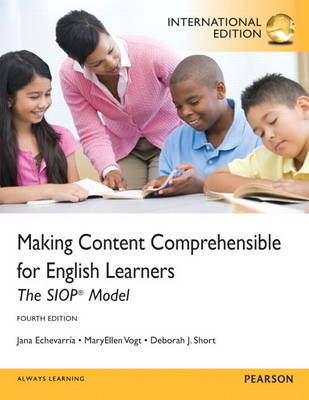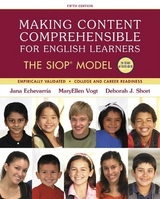
Making Content Comprehensible for English Learners
Pearson (Verlag)
978-0-13-306076-8 (ISBN)
- Titel erscheint in neuer Auflage
- Artikel merken
New with the fourth edition is an accompanying online resource site, PDToolkit for SIOP®.
The new website includes:
Information About the Authors
SIOP® Research
SIOP® Resources
SIOP® Lesson Plans and Activities
SIOP® Videos
To learn more, please visit: http://pdtoolkit.pearson.com.
Jana Echevarría is a Professor Emerita at California State University, Long Beach. She has taught in elementary, middle, and high schools in general education, special education, ESL, and bilingual programs. She has lived in Taiwan, Spain and Mexico. An internationally known expert on second language learners, Dr. Echevarría is a Fulbright Specialist. Her research and publications focus on effective instruction for English learners, including those with learning disabilities. Currently, she is Co-Principal Investigator with the Center for Research on the Educational Achievement and Teaching of English Language Learners (CREATE) funded by the U.S. Department of Education, Institute of Education Sciences (IES). In 2005, Dr. Echevarría was selected as Outstanding Professor at CSULB. MaryEllen Vogt, Ed.D., is a Professor Emerita of Education at California State University, Long Beach. Dr. Vogt has been a classroom teacher, reading specialist, special education specialist, curriculum coordinator, and university teacher educator. She received her doctorate from the University of California, Berkeley, and is a co-author of fifteen books, including Reading Specialists and Literacy Coaches in the Real World (3rd ed., 2011) and the SIOP® book series. Her research interests include improving comprehension in the content areas, teacher change and development, and content literacy and language acquisition for English learners. She was inducted into the California Reading Hall of Fame, received her university’s Distinguished Faculty Teaching Award, and served as President of the International Reading Association in 2004–2005. Deborah J. Short is a professional development consultant and a senior research associate at the Center for Applied Linguistics in Washington, DC. She co-developed the SIOP® Model for sheltered instruction and has directed national research studies on English language learners funded by the Carnegie Corporation, the Rockefeller Foundation, and the U.S. Dept. of Education. She chaired an expert panel on adolescent ELL literacy that produced a policy report. As the director of Academic Language Research & Training, Dr. Short provides professional development on sheltered instruction and academic literacy around the U.S. and abroad. She has numerous publications, including the SIOP® book series and five ESL textbook series for National Geographic/Hampton-Brown. She has taught English as a second/foreign language in New York, California, Virginia, and the Democratic Republic of Congo.
Preface and Acknowledgments
1 Introducing the SIOP Model
Content and Language Objectives
Background on English Learners
Demographic Trends
Diverse Characteristics
Achievement Gaps
School Reform, Standards and Accountability
Preparing English Learners to be College and Career Ready
Academic Language and Literacy
Relationship to Second Language Learning
Role in Schooling
Research on Academic Language and Literacy
Effective Instructional Practice for English Learners: The SIOP® Model
Content-based ESL and Sheltered Content Instruction
Research and Development of the Sheltered Instruction Observation Protocol (SIOP) Model
Effective SIOP Model Instruction
Implementing the SIOP® Model
Summary
Discussion Questions
2 Lesson Preparation
Content and Language Objectives
Background
SIOP® Feature 1: Content Objectives Clearly Defined, Displayed, and Reviewed with Students
SIOP® Feature 2: Language Objectives Clearly Defined, Displayed, and Reviewed with Students
Writing Content and Language Objectives
SIOP® Feature 3: Content Concepts Appropriate for Age and Educational Background
SIOP® Feature 4: Supplementary Materials Used to a High Degree
SIOP® Feature 5: Adaptation of Content to All Levels of Student Proficiency
SIOP® Feature 6: Meaningful Activities That Integrate Lesson Concepts with Language Practice Opportunities
Teaching Ideas for Lesson Preparation
Differentiating Ideas for Multi-Level Classes
Rating Lessons with the SIOP® Protocol
The Lesson
The Gold Rush (Fourth Grade)
Teaching Scenarios
Discussion of Lessons
Summary
Discussion Questions
3 Building Background
Content and Language Objectives
Background
SIOP® Feature 7: Concepts Explicitly Linked to Students’ Background Experiences
Instructional Implications
SIOP® Feature 8: Links Explicitly Made between Past Learning and New Concepts
SIOP® Feature 9: Key Vocabulary Emphasized (e.g., introduced, written, repeated, and highlighted for students to see)
Academic Language
Academic Word List
Vocabulary Instruction
Teaching Ideas for Building Background
Differentiating Ideas for Multi-Level Classes
The Lesson
Two Were Left (Sixth Grade)
Teaching Scenarios
Discussion of Lessons
Summary
Discussion Questions
4 Comprehensible Input
Content and Language Objectives
Background
SIOP® Feature 10: Speech Appropriate for Students’ Proficiency Levels
SIOP® Feature 11: Clear Explanation of Academic Tasks
SIOP® Feature 12: A Variety of Techniques Used to Make Content Concepts Clear
Teaching Ideas for Comprehensible Input
Differentiating Ideas for Multi-Level Classes
The Lesson
Buoyancy (Ninth Grade)
Teaching Scenarios
Discussion of Lessons
Summary
Discussion Questions
5 Strategies
Content and Language Objectives
Background
SIOP® Feature 13: Ample Opportunities Provided for Students to Use Learning Strategies
SIOP® Feature 14: Scaffolding Techniques Consistently Used, Assisting and Supporting Student Understanding
SIOP® Feature 15: A Variety of Questions or Tasks That Promote Higher-Order Thinking Skills
Teaching Ideas for Strategies
Differentiating Ideas for Multi-Level Classes
The Lesson
The Rain Forest (Seventh Grade)
Teaching Scenarios
Discussion of Lessons
Summary
Discussion Questions
6 Interaction
Content and Language Objectives
Background
Mainstream Lesson
SIOP® Model
SIOP® Feature 16: Frequent Opportunities for Interaction and Discussion
Oral Language Development
Other Opportunities for Interaction
SIOP® Feature 17: Grouping Configurations Support Language and Content Objectives of the Lesson
SIOP® Feature 18: Sufficient Wait Time for Student Responses Consistently Provided
SIOP® Feature 19: Ample Opportunity for Students to Clarify Key Concepts in L1
Teaching Ideas for Interaction
Differentiating Ideas for Multi-Level Classes
The Lesson
Addition and Subtraction (First Grade)
Teaching Scenarios
Discussion of Lessons
Summary
Discussion Questions
7 Practice & Application
Content and Language Objectives
Background
SIOP® Feature 20: Hands-On Materials and/or Manipulatives Provided for Students to Practice Using New Content Knowledge
SIOP® Feature 21: Activities Provided for Students to Apply Content and Language Knowledge
SIOP® Feature 22: Activities That Integrate All Language Skills
Teaching Ideas for Practice & Application
Differentiating Ideas for Multi-Level Classes
The Lesson
The Solar System (Ninth Grade Newcomers, aged 15-18)
Teaching Scenarios
Discussion of Lessons
Summary
Discussion Questions
8 Lesson Delivery
Content and Language Objectives
Background
SIOP® Feature 23: Content Objectives Clearly Supported by Lesson Delivery
SIOP® Feature 24: Language Objectives Clearly Supported by Lesson Delivery
Meeting Content and Language Objectives
SIOP® Feature 25: Student Engaged Approximately 90% to 100% of the Period
SIOP® Feature 26: Pacing of the Lesson Appropriate to Students’ Ability Levels
Teaching Ideas for Lesson Delivery
Differentiating Ideas for Multi-Level Classes
The Lesson
The Gold Rush (Fourth Grade)
Teaching Scenarios
Discussion of Lessons
Summary
Discussion Questions
9 Review & Assessment
Content and Language Objectives
Background
SIOP® Feature 27: Comprehensive Review of Key Vocabulary
SIOP® Feature 28: Comprehensive Review of Key Content Concepts
SIOP® Feature 29: Regular Feedback Provided to Students on Their Output
SIOP® Feature 30: Assessment of Student Comprehension and Learning of All Lesson Objectives throughout the Lesson
Teaching Ideas for Review & Assessment
Differentiating Ideas for Multi-Level Classes
The Lesson
Egyptian Mummies (Eighth Grade)
Teaching Scenarios
Discussion of Lessons
Summary
Discussion Questions
10 Issues of Reading, RTI and Special Education for English Learners
Content and Language Objectives
Issues of Reading and Assessment
Assisting Struggling Learners: Response to Intervention
Issues Related to Special Education
Special Education Services: When Are They Appropriate?
Search for Intervention Rather than Disability
Teaching Ideas for Students with Special Needs
Summary
Discussion Questions
11 Effective Use of the SIOP® Protocol
Content and Language Objectives
Best Practice in Using the SIOP® Protocol
Scoring and Interpreting the SIOP® Protocol
Assigning Scores
Not Applicable (NA) Category
Calculating Scores
Sample Lesson
Using SIOP® Scores and Comments
Ideas for Using the SIOP protocol
Reliability and Validity of the SIOP®
Summary
Discussion Questions
12 Frequently Asked Questions about Getting Started with the SIOP® Model
Content and Language Objectives
General SIOP Questions
Questions about Getting Started with the SIOP® Model in the Classroom
Questions About School-wide Implementation of the SIOP Model
Conclusion
Appendix A: The Sheltered Instruction Observation Protocol (SIOP®)
Appendix B: Lesson Plans
Appendix C: Research on the SIOP® Model
Appendix D: SIOP Professional Development Books and Resources
Glossary
References
Index
| Erscheint lt. Verlag | 28.6.2012 |
|---|---|
| Sprache | englisch |
| Maße | 214 x 272 mm |
| Gewicht | 840 g |
| Themenwelt | Schulbuch / Wörterbuch ► Wörterbuch / Fremdsprachen |
| Geisteswissenschaften ► Sprach- / Literaturwissenschaft ► Sprachwissenschaft | |
| Sozialwissenschaften ► Pädagogik | |
| ISBN-10 | 0-13-306076-4 / 0133060764 |
| ISBN-13 | 978-0-13-306076-8 / 9780133060768 |
| Zustand | Neuware |
| Haben Sie eine Frage zum Produkt? |
aus dem Bereich



